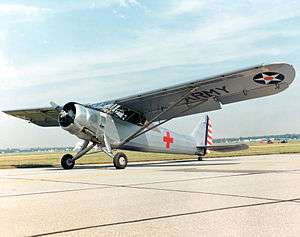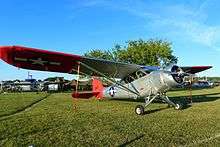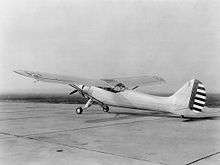Stinson L-1 Vigilant
The Stinson L-1 Vigilant (company designation Model 74) was a 1940s American light observation aircraft built by the Stinson Aircraft Company at Wayne, Michigan (by November 1940 a division of Vultee Aircraft Corporation).[1] The aircraft was operated by the United States Army Air Corps as the O-49 until 1942.
| L-1 (O-49) Vigilant | |
|---|---|
 | |
| Role | Light Observation, Liaison |
| Manufacturer | Stinson Aircraft Corporation |
| Designer | A.P. Fontaine |
| First flight | 15 July 1940 |
| Introduction | 1941 |
| Primary users | United States Army Air Corps Royal Air Force |
| Number built | 324 |
Design and development
The Vigilant was designed in response to a 1938 United States Army Air Corps design competition for a two-seat light observation aircraft. When the German-manufactured Fieseler Storch was demonstrated at the Cleveland Air Races, the Air Corps revised its specifications in an attempt to match the performance of the Storch. Stinson (later a division of Vultee), won the $1.5 million contract over 11 competitors, including the Bellanca YO-50 and Ryan YO-51 Dragonfly.[2]
The Model 74 was a single radial engined high-wing monoplane with trailing-edge high-lift devices for low speed and high lift performance. The prototype aircraft was built with full-span leading-edge automatic slots manufactured by Handley Page, and slotted flaps. The Model V-74 was given the Army designation YO-49 for evaluation, with the first flight by test pilot Al Schramm on 15 July 1940.[2]
The aircraft was built of steel tubing and fabric, with the fuselage forward of the wing enclosed in sheet metal. Control surfaces and the empennage were fabric-covered stainless steel. The Lycoming power plant was hand-cranked inertia starting, and was fitted with a Hamilton Standard constant speed propeller. At least 12 ambulance conversions were fitted with Edo 49-4000 floats (4,000-pound displacement)[3] for amphibious landings and takeoffs.[2]
The Vigilant was capable of stopping in less than its own length, and could maintain stable flight at 31 miles per hour. Anecdotally, the Vigilant was said to be capable of backwards flight in a strong headwind.[2]
Operational history


The Stinson Vigilant was used in diverse roles such as towing training gliders, artillery spotting, liaison, emergency rescue, transporting supplies and special espionage flights.[4] Another contract was later awarded for the O-49A which had a slightly longer fuselage and other equipment changes. In April 1942 the aircraft were redesignated the L-1 and L-1A (liaison). Up to 17 L-1 and 96 L-1A aircraft were allocated to the British Royal Air Force under the Lend-Lease Act, with varying numbers given for aircraft actually delivered (see Variants, below). The RAF designated the aircraft the Vigilant Mk I and Vigilant Mk II respectively. General Harry Crerar, Commander of the First Canadian Army in Europe during World War II, maintained a Vigilant for his personal use.
Aircraft were modified for a variety of roles including as an ambulance aircraft. No further production orders were placed as the aircraft was superseded by procurement of vast numbers of both the militarized Piper J-3 Cub, the L-4 Grasshopper (in addition to Aeronca's and Taylorcraft's similar conversions), and Stinson's own L-5 Sentinel, itself produced in nearly 4,000 examples; were all generically classified as "puddle-jumper" aircraft.
A Vigilant was modified in 1943–1944 for experiments in boundary layer control.[5]
Variants

- Stinson Model 74
- company designation
- O-49 Vigilant
- U.S. Army designation for first production batch, 142 built.[3]
- L-1 Vigilant
- 1942 redesignation of O-49.[3]
- O-49A Vigilant
- Fuselage lengthened 13 in (33 cm)[6] 182 built.
- O-49B Vigilant
- Conversion to ambulance variant, three or four[7] converted.
- L-1A Vigilant
- 1942 redesignation of O-49A.[3]
- L-1B Vigilant
- 1942 redesignation of O-49B.[3]
- L-1C Vigilant
- L-1A ambulance variant, 113 converted.[7]
- L-1D Vigilant
- L-1A training glider tug, 14 to 21[7] converted.
- L-1E Vigilant
- L-1 amphibious ambulance variant, seven converted.[3]
- L-1F Vigilant
- L-1A amphibious ambulance variant, five conversions.[3]
- Vigilant Mk I
- RAF designation of L-1, 14[7] to 17 allocated by Lend Lease
- Vigilant Mk II
- RAF designation of L-1A, 96 allocated, circa 13 to 54[7] delivered
- CQ-2 Vigilant
- US Navy conversion of L-1A to target control aircraft, one or more[7] converted
Surviving aircraft
- Airworthy
- 40-3102 – operated by the Fantasy of Flight in Polk City, Florida.[8][9][10] This aircraft flew for the first time after restoration on 18 July 2013.[11]
- 41-18915 – operated by the Alaska Aviation Heritage Museum in Anchorage, Alaska.[12][13][14]
- 41-19031 – privately owned and operated in Blaine, Minnesota.[15][16]
- On Display
- 41-19039 – National Museum of the United States Air Force in Dayton, Ohio.[17]
- Under restoration or in storage
- 40-0283 – under restoration by G & P.M. Turner in London.[18]
- 40-3141 – in storage at the United States Army Aviation Museum at Fort Rucker, Alabama.[19]
Specifications (L-1A)
Data from American Warplanes of World War II[20]
General characteristics
- Crew: 3
- Length: 34 ft 3 in (10.44 m)
- Wingspan: 50 ft 11 in (15.52 m)
- Height: 10 ft 2in (3.10 m)
- Wing area: 329 ft2 (30.6 m2)
- Empty weight: 2,670 lb (1,211 kg)
- Max. takeoff weight: 3,400 lb (1,542 kg)
- Powerplant: 1 × Lycoming R-680-9 radial piston engine, 295 hp (220 kW)
Performance
- Maximum speed: 106 knots (122 mph, 196 km/h)
- Range: 243 nm (280 mi, 451 km)
- Service ceiling: 12,800 ft (3,900 m)
- Rate of climb: 408 ft/min (124.36 m/min)
- Wing loading: 10.3 lb/ft2 (50.4 kg/m2)
- Power/mass: 0.0867 hp/lb (0.143 kW/kg)
See also
Aircraft of comparable role, configuration and era
- Bellanca YO-50
- Fieseler Fi 156
- Miles Messenger
- Polikarpov Po-2
- Repülőgépgyár Levente II
- Ryan YO-51 Dragonfly
- Westland Lysander
Related lists
References
Notes
- Eden and Moeng 2002, p. 1100.
- Merriam 2002, p. 26.
- Merriam 2002, p. 27.
- Adcock 2005, p. 7.
- "Money-box Slottery." Flight, 4 August 1949, p. 124.
- "Vultee L-1A Vigilant." National Museum of the United States Air Force, 17 April 2009.
- "Stinson O-49." Aerofiles, 17 April 2009.
- "1941 Stinson Vultee L-1E". Fantasy of Flight. Fantasy of Flight. Retrieved 13 August 2016.
- "Airframe Dossier – Stinson L-1 Vigilant, s/n 40-3102 USAAF, c/r N63230". Aerial Visuals. AerialVisuals.ca. Retrieved 13 August 2016.
- "FAA Registry: N63230." faa.gov Retrrieved: 12 February 2020.
- "Fantasy of Flight's Stinson L-1 Flew Today!". Warbirds News. Warbirds News. Retrieved 13 August 2016.
- "1941 STINSON L-1". Alaska Aviation Museum. Alaska Aviation Museuma. Retrieved 12 February 2020.
- "Airframe Dossier – Stinson L-1F Vigilant, s/n 41-18915, c/r N1ZS". Aerial Visuals. AerialVisuals.ca. Retrieved 13 August 2016.
- "FAA Registry: N1ZS." faa.gov Retrieved: 12 February 2020.
- "Airframe Dossier – Stinson L-1 Vigilant, s/n 41-19031 USAAF, c/r N1377B". Aerial Visuals. AerialVisuals.ca. Retrieved 13 August 2016.
- "FAA Registry: N1377B." faa.gov Retrieved: 12 February 2020.
- "Vultee L-1A Vigilant". National Museum of the US Air Force. Retrieved 13 August 2016.
- "Airframe Dossier – Stinson L-1 Vigilant, s/n 40-283, c/r GCIGB". Aerial Visuals. AerialVisuals.ca. Retrieved 12 February 2020.
- "Airframe Dossier – Stinson L-1B Vigilant, s/n 40-3141, c/r 79". Aerial Visuals. AerialVisuals.ca. Retrieved 12 February 2020.
- Donald 1995, p. 236.
Bibliography
- Adcock, Al. US Liaison Aircraft in action (Aircraft in Action: No. 195). Carrollton, Texas: Squadron/Signal Publications, 2005. ISBN 978-0897474870.
- Donald, David (ed.). American Warplanes of World War II. London: Aerospace Publishing, 1995. ISBN 1-874023-72-7.
- Eden, Paul and Soph Moeng (eds.). The Complete Encyclopedia of World Aircraft. London: Amber Books Ltd., 2002. ISBN 0-7607-3432-1
- Merriam, Ray (ed.). World War II Journal #15: U.S. Military Aircraft of World War II. Bennington, Vermont, USA: Merriam Press, 2002. ISBN 1-57638-167-6.
- Ogden, Bob. Aviation Museums and Collections of North America. Tonbridge, Kent, UK: Air-Britain (Historians ) Ltd, 2007. ISBN 0-85130-385-4.
- The Illustrated Encyclopedia of Aircraft (Part Work 1982–1985). London: Orbis Publishing, 1985.
External links
| Wikimedia Commons has media related to Stinson L-1 Vigilant. |